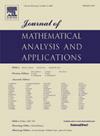Restricted slowly growing digits for infinite iterated function systems
IF 1.2
3区 数学
Q1 MATHEMATICS
Journal of Mathematical Analysis and Applications
Pub Date : 2025-03-14
DOI:10.1016/j.jmaa.2025.129478
引用次数: 0
Abstract
For an infinite iterated function system f on with an attractor and for an infinite subset , consider the set For a function such that as , we compute the Hausdorff dimension of the set We prove that the Hausdorff dimension stays the same no matter how slowly the function φ grows. One of the consequences of our result is the recent work of Takahasi (2023), which only dealt with regular continued fraction expansions. We further extend our result to slowly growing products of (not necessarily consecutive) digits.
求助全文
约1分钟内获得全文
求助全文
来源期刊
CiteScore
2.50
自引率
7.70%
发文量
790
审稿时长
6 months
期刊介绍:
The Journal of Mathematical Analysis and Applications presents papers that treat mathematical analysis and its numerous applications. The journal emphasizes articles devoted to the mathematical treatment of questions arising in physics, chemistry, biology, and engineering, particularly those that stress analytical aspects and novel problems and their solutions.
Papers are sought which employ one or more of the following areas of classical analysis:
• Analytic number theory
• Functional analysis and operator theory
• Real and harmonic analysis
• Complex analysis
• Numerical analysis
• Applied mathematics
• Partial differential equations
• Dynamical systems
• Control and Optimization
• Probability
• Mathematical biology
• Combinatorics
• Mathematical physics.

 求助内容:
求助内容: 应助结果提醒方式:
应助结果提醒方式:


